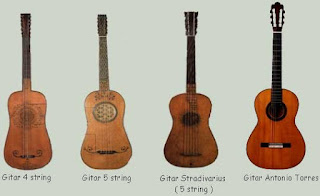Modern guitar incarnation first appeared in the Renaissance. Guitar at that time had four pairs of strings named course. Guitar in Renaiss ance also has much in common with the vihuela of Spain which is a musical instrument with a 6 course with tuning and the same construction. In 1555, Juan Bermudo publish Declaracion de Instrumentos Musicales, an agreement in which there are parts of stringed plucked musical instrument. This publication examines the relationship between dah vihuela guitar, and also distinguish between guitars with 4 and 5 course. Guitar with 4 course itself does not reach the point where they could be eliminated by a guitar with a 5 course until the Baroque period.
Until the 16th century, the vihuela into a musical instrument that is very popular in Spain and Italy. This instrument seems to have a strong influence both in terms of design and tuning of guitars 5 course which first appeared in Spain in the mid 16th century. Some time later, a guitar with a 5 course began to slowly replace the Renaissance guitar which has four courses, especially in Spain. Guitars 5 this course then sets the modern standard tuning - A, D, G, B, E - as a string of top that continues to this day. Since the mid 18th century until the early 19th century, the guitar began to evolve into a musical instrument with six strings. 6 string guitar at that time still smaller than the modern guitar.
Modern classical guitar that exist now owe everything to Antonio de Torres. Construction guitars is considered as a standard in the manufacture of traditional musical instruments since the mid-19th century. Contemporary classical guitar himself following in the footsteps Smallman design that replaces the fan brace with balsa brace lighter, paired on the rear of the soundboard with carbon fiber. Balsa This brace has a honeycomb pattern and allow the soundboard to produce more modes of vibration. This allows for the guitar can have a louder voice.
On development, conducted several experiments to try mengamplify vibration on stringed instruments. This experiment has been done much since the beginning of the 20th century. There are several patents from 1910 that shows the adaptation and application of a transmitter for a phone that is placed on the violin and banjo-by mengamplify voice. Hobbyists guitar in 1920 also conduct these experiments, where they use the carbon microphone button which is placed on the bridge. Unfortunately, instead laying the microphone captures the vibration of the bridge above the instrument, resulting in a poor signal.
History of the origin of the electric guitar itself was originally designed by the guitar maker and the manufacturing of musical instruments. Some electric guitar in the early days of adapting the acoustic musical instrument body is empty and using tungsten pickup. The first electric guitar was designed in 1931 by George Beauchamp, a General Manager at the National Guitar Corporation along with Paul Barth who became vice president in the same place. Prototype named "Frying Pan" has a color like maple and built by Harry Watson, a Factory Superintendent of the National Guitar Corporation. Purwarpa is starting to get into the stage of commercial production at the end of the summer of 1932 by the Ro-Pat-In Corporation (stands for Electro-Patent-Instrument Company of Los Angeles), business partners Beauchamp, Adolph Rickenbacker, and Paul Barth. In 1934, the company changed its name to Rickenbacker Electro stringed Instrument Company.
Modern classical guitar that exist now owe everything to Antonio de Torres. Construction guitars is considered as a standard in the manufacture of traditional musical instruments since the mid-19th century. Contemporary classical guitar himself following in the footsteps Smallman design that replaces the fan brace with balsa brace lighter, paired on the rear of the soundboard with carbon fiber. Balsa This brace has a honeycomb pattern and allow the soundboard to produce more modes of vibration. This allows for the guitar can have a louder voice.
On development, conducted several experiments to try mengamplify vibration on stringed instruments. This experiment has been done much since the beginning of the 20th century. There are several patents from 1910 that shows the adaptation and application of a transmitter for a phone that is placed on the violin and banjo-by mengamplify voice. Hobbyists guitar in 1920 also conduct these experiments, where they use the carbon microphone button which is placed on the bridge. Unfortunately, instead laying the microphone captures the vibration of the bridge above the instrument, resulting in a poor signal.
History of the origin of the electric guitar itself was originally designed by the guitar maker and the manufacturing of musical instruments. Some electric guitar in the early days of adapting the acoustic musical instrument body is empty and using tungsten pickup. The first electric guitar was designed in 1931 by George Beauchamp, a General Manager at the National Guitar Corporation along with Paul Barth who became vice president in the same place. Prototype named "Frying Pan" has a color like maple and built by Harry Watson, a Factory Superintendent of the National Guitar Corporation. Purwarpa is starting to get into the stage of commercial production at the end of the summer of 1932 by the Ro-Pat-In Corporation (stands for Electro-Patent-Instrument Company of Los Angeles), business partners Beauchamp, Adolph Rickenbacker, and Paul Barth. In 1934, the company changed its name to Rickenbacker Electro stringed Instrument Company.

No comments:
Post a Comment